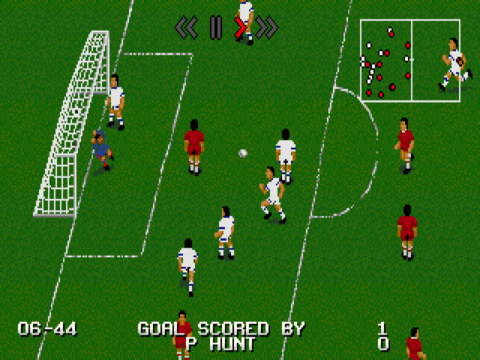
European Champions
Written by: Rik
Date posted: June 2, 2013
- Genre: Sport
- Developed by: Audiogenic
- Published by: Ocean
- Year released: 1994
- Our score: 5
Somewhere back in the mists of time, a game called Emlyn Hughes International Soccer was considered the premier choice for 8-bit football fans everywhere. Having achieved considerable success on the Spectrum, Amstrad CPC and Commodore 64, it was rather less well-received on the 16-bit formats, with gamers generally preferring the fast-paced overhead action offered by the likes of Kick Off 2 and Sensible Soccer.
It seems likely that this was a factor in the subsequent re-jigging of Emlyn Hughes as European Champions, with the game’s packaging and advertising campaign drawing attention to the inclusion of a top-down view, as part of a ‘best of both worlds’ footy title that allowed you to choose between a visually appealing side-on perspective and the birds eye approach favoured by the leading titles of the day. (As an aside, I should say that if my description of this game as a ‘re-jigging’ of a previous game seems a little harsh, I can only blame numerous bad experiences courtesy of the very same developer, who enticed me to spend a lot of money on largely-identical cricket games over the years. Also, they later re-released European Champions again, with a few tweaks, as Wembley International Soccer – boo, hiss etc.)
In case my natural world-weary cynicism overshadowed that last paragraph, I should make the following clear: this major selling point of European Champions was very appealing to me at the time. Despite a fondness for Kick Off, the prospect of a half-decent side-on football title was one I found difficult to resist, and, unaware of the game’s Emlyn Hughes origins, the idealised version of the game I carried around with my head was essentially Kick Off 2 with a different camera and better graphics. Had I been able to locate a copy of the Atari ST version (for more on which, see ST Champions) or had regular access to a PC at the time of release, I would certainly have given it a go. Instead, though, it had to be added to the list of games I would have liked to have played at the time, had I not been prevented from doing so for some reason or another (most common reason: I had an Atari ST) but which, thanks to technology and abandonware, I would eventually have the chance to revisit. And once the link to Emlyn Hughes became apparent, I had twice the motivation to do so. [Fascinating! And how do you feel now you’ve written the review? – sarcastic reader].
Aside from the ability to switch view dynamically (more on which in a second), the other main draw of European Champions (and other main difference from Emlyn Hughes) was the inclusion of three different passing modes, a novelty in the days of one-button joysticks. By tapping the button lightly you can play a ‘ping’ pass to a fellow player highlighted on your rader; ‘point’ passing is achieved by releasing the direction control, holding down the button and then selecting the direction you wish to pass in; and finally, there is the ‘crosshair’ pass (which is basically the same method as for shooting at goal), whereby you hold the button down without first releasing the direction control, and guide the crosshair that appears in front of your player to control the general direction of your kick.
Let’s deal with the camera issue first, because it’s a quick one – it works, but it’s largely a gimmick. There seems little reason to use the top-down view: the game (despite my adolescent idealisation) doesn’t play like Kick Off at all; it looks better in the side-on view anyway; and, worst of all, it suffers badly from the camera being unable to keep up with the action. Emlyn Hughes was always a side-on game, and the top-down view just seems like it’s been tacked on as an afterthought. I suppose you do have to give some credit for technical achievement (for the time) but it doesn’t have much practical use.
The passing system is a slightly more successful innovation. While the action is hardly conducted at a pace you’d describe as considered, it’s still easily distinguishable from the kick and rush madness on show in the likes of Goal!. ‘Ping’ passes are, obviously, the easiest to pull off, although your chances of consciously observing who the receiver will be before hammering the button are pretty slim at the best of times. Occasionally, though, you will get some time and space on the ball, and you can pull off a decent and measured ‘point’ pass under such circumstances. Crosshair, on the other hand, is best disregarded as a passing option altogether, unless it’s used to lump the ball forward aimlessly (which can be useful during periods of fraught defence).
As far as control systems operating under specific constraints go, it’s pretty good, and even playing the game is on keyboard is fairly acceptable, which is no mean feat. Tactics generally involve trying to retain possession, getting it to the man in space and blasting it goalwards from long range, or firing in an optimistic ‘ping’ pass from wide areas in the hope of getting a headed finish on goal. However you score, though, it’s worth nothing that there’s a significant “YESSSSSS!” *fist pump* factor when the ball finds the net, and that’s not always a given when it comes to football games (from recent memory, the tepid FIFA 07, in particular, comes to mind). Defending is not without its subtleties either: you can either hustle an opponent with the ball by running into him, or stick him with a slide tackle when things get a little more desperate. The latter is rather hit and miss – as it should be, of course – and a good balance between risk and success seems to have been struck here.
To its credit, then, European Champions is a more considered and subtle affair than some of its contemporaries, but that’s not to say that it isn’t still fairly fast and furious, and keeping the ball without making blind and frenetic use of the ‘ping’ pass is virtually impossible. It’s less hit-and-hope than some, but there remains a certain randomness to proceedings, with victories often coming in fraught circumstances by narrow margins, and you rarely feel in control of a match.
Sustained play reveals some irritating idiosyncracies, too. For example, you can add air to long-range shots, but it’ll only result in you ballooning the ball over the bar, so there’s no point in trying. When slide-tackling, two players will often attempt the tackle at exactly the same time, unnecessarily taking a second player out of the game if you’re unsuccessful. When it comes to free kicks, just blasting it at the goal seems to have a very high success rate, but the computer has dirty tricks of its own at set pieces, its favourite being to send an attacker into an offside position (although no offside is ever given) and end up scoring regardless of what you do. Speaking of the computer player, it has a habit of getting players into a good shooting position but then just dribbling the ball towards your ‘keeper until he takes possession. At higher skill levels, it’s much too aggressive in the tackle and will give you a false sense of hope by almost always having someone sent off – they often still win anyway, though.
Still, it’s certainly playable enough, although after a while, once you’ve got the hang of things, you’ll find little to sustain your interest. As with many sports games of the era, European Champions is sorely lacking in bells and whistles – there’s the usual option to play a friendly, a league or a cup, but there’s little in the way of player attributes or stats tracking. In fact, when you load a game you still have to go to the options screen again to identify the team you started your league/cup with – that’s the level we’re at here.
On an audio-visual level, it all looks fairly okay – I quite liked the attention to detail on the kits: the Liverpool strip closely replicated the one of the era (1993 – white stripes over the shoulder, plus authentically horrible green away shirt). Sound is best described as sparse, with incidental crowd noise lacking completely, and matches are largely conducted with some incessant bleeping (for when the player available for a ‘ping’ pass changes) as the sole aural accompaniment. It doesn’t look or sound as good as the other 16-bit computer versions, but it seems to move a lot better, so that’s probably a worthwhile trade-off (although I don’t know why there had to be one at all – the PC version should look and sound the best, dammit).
Anyone expecting a game called European Champions to give you some kind of reward screen for, you know, becoming European Champions is going to be disappointed, too. You just get a screen confirming that you won, then it’s back to the menu and so in terms of effort/reward you may as well just lose the final and pretend you were playing as the other team. By the time you get to that stage (assuming you chose a moderately challenging difficulty level, mind) you’ll have probably had your fill of the game – there’s enough here to keep you going in pursuit of a trophy, but a full league campaign would be a bit of a stretch.
European Champions isn’t without charm, though, and at times it reminded me of a prototype Puma World Football. For a low-profile, long-forgotten football game from the 90s, it certainly isn’t terrible, and seems to have aged better than some of its more celebrated contemporaries. If you’re interested in this kind of thing, and missed out first time around, European Champions will provide you with a good weekend’s worth of fun.

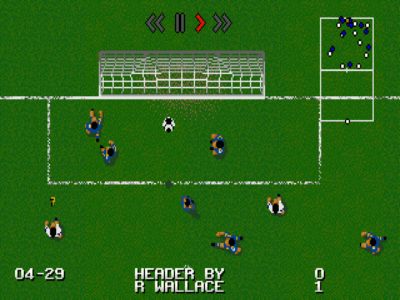
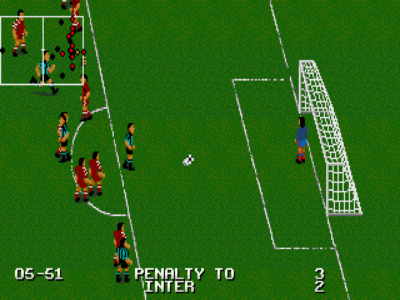
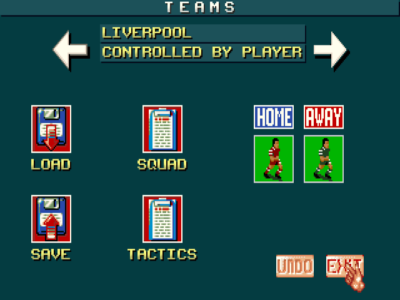
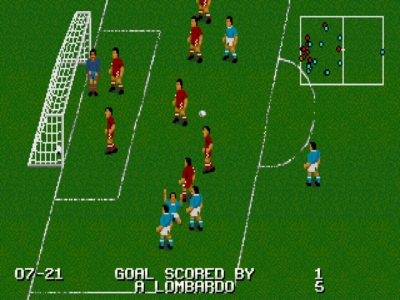

 Posts
Posts